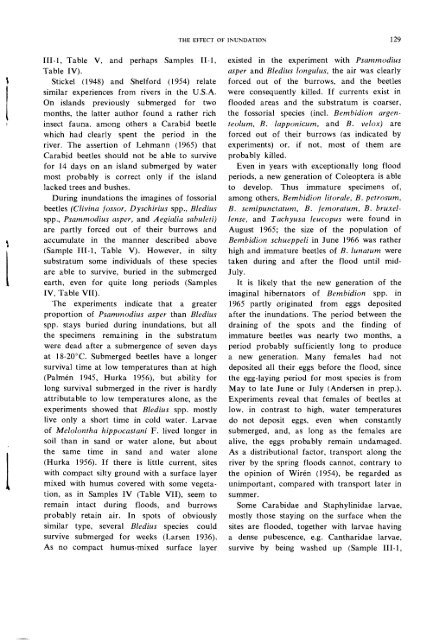NORSK ENTOMOLOGISK TIDSSKRIFT - Norsk entomologisk forening
NORSK ENTOMOLOGISK TIDSSKRIFT - Norsk entomologisk forening
NORSK ENTOMOLOGISK TIDSSKRIFT - Norsk entomologisk forening
Create successful ePaper yourself
Turn your PDF publications into a flip-book with our unique Google optimized e-Paper software.
\<br />
I<br />
\<br />
I<br />
1<br />
Ill-I, Table V, and perhaps Samples 11-1,<br />
Table IV).<br />
Stickel (194S) and Shelford (1954) relate<br />
similar experiences from rivers in the D.S.A.<br />
On islands previously submerged for two<br />
months, the latter author found a rather rich<br />
insect fauna. among others a Carabid beetle<br />
which had clearly spent the period in the<br />
river. The assertion of Lehmann (1965) that<br />
Carabid beetles should not be able to survive<br />
for 14 days on an island submerged by water<br />
most probably is correct only if the island<br />
lacked trees and bushes.<br />
During inundations the imagines of fossorial<br />
beetles (Clivilla fossor, Dyschirius spp., Bledius<br />
spp., Psammodius asper, and Aegialia sabuleti)<br />
are partly forced out of their burrows and<br />
accumulate in the manner described above<br />
(Sample Ill-I, Table V). However, in silty<br />
substratum some individuals of these species<br />
are able to survive, buried in the submerged<br />
earth, even for quite long periods (Samples<br />
IV, Table VII).<br />
The experiments indicate that a greater<br />
proportion of Psammodius asper than Bledius<br />
spp. stays buried during inundations, but all<br />
the specimens remaining in the substratum<br />
were dead after a submergence of seven days<br />
at IS-20°C. Submerged beetles have a longer<br />
survival time at low temperatures than at high<br />
(Palmen 1945, Hurka 1956), but ability for<br />
long survival submerged in the river is hardly<br />
attributable to low temperatures alone, as the<br />
experiments showed that Bledius spp. mostly<br />
live only a short time in cold water. Larvae<br />
of Melololltha hippocastalli F. lived longer in<br />
soil than in sand or water alone, but about<br />
the same time in sand and water alone<br />
(Hurka 1956). If there is little current, sites<br />
with compact silty ground with a surface layer<br />
mixed with humus covered with some vegetation,<br />
as in Samples IV (Table VII), seem to<br />
remain intact during floods, and burrows<br />
probably retain air. In spots of obviously<br />
similar type, several Bledius species could<br />
survive submerged for weeks (Larsen 1936).<br />
As no compact humus-mixed surface layer<br />
THE EFFECT OF INUNDAnON 129<br />
existed in the experiment with Psammodius<br />
asper and Bledius IOllgulus, the air was clearly<br />
forced out of the burrows, and the beetles<br />
were consequently killed. If currents exist in<br />
flooded areas and the substratum is coarser,<br />
the fossorial species (incl. Bembidioll argenteolum,<br />
B. lappollicum. and B. velox) are<br />
forced out of their burrows (as indicated by<br />
experiments) or, if not, most of them are<br />
probably killed.<br />
Even in years with exceptionally long flood<br />
periods, a new generation of Coleoptera is able<br />
to develop. Thus immature specimens of,<br />
among others, Bembidioll lit orale, B. petrosum.<br />
B. semipullctatum, B. femoratum. B. bruxellellSe,<br />
and Tachyusa leucopus were found in<br />
August 1965; the size of the population of<br />
Bembidioll schueppeli in June 1966 was rather<br />
high and immature beetles of B. IUllatum were<br />
taken during and after the flood until mid<br />
July.<br />
It is likely that the new generation of the<br />
imaginal hibernators of Bembidioll spp. in<br />
1965 partly originated from eggs deposited<br />
after the inundations. The period between the<br />
draining of the spots and the finding of<br />
immature beetles was nearly two months, a<br />
period probably sufficiently long to produce<br />
a new generation. Many females had not<br />
deposited all their eggs before the flood, since<br />
the egg-laying period for most species is from<br />
May to late June or July (Andersen in prep.).<br />
Experiments reveal that females of beetles at<br />
low. in contrast to high, water temperatures<br />
do not deposit eggs, even when constantly<br />
submerged, and, as long as the females are<br />
alive, the eggs probably remain undamaged.<br />
As a distributional factor, transport along the<br />
river by the spring floods cannot, contrary to<br />
the opinion of Wiren (1954), be regarded as<br />
unimportant, compared with transport later in<br />
summer.<br />
Some Carabidae and Staphylinidae larvae,<br />
mostly those staying on the surface when the<br />
sites are flooded, together with larvae having<br />
a dense pubescence, e.g. Cantharidae larvae,<br />
survive by being washed up (Sample Ill-I,

















